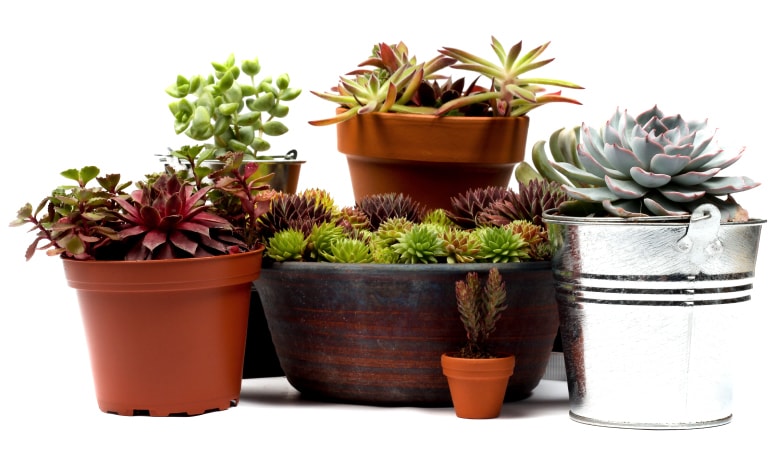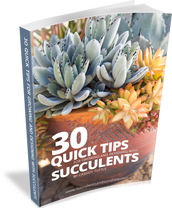
USA plant hardiness
Pictured here is the basic USDA Hardiness
Zone Map. Click the image (or click here)
to go to the USDA website and get more
detailed info about your specific zone.
What Are Hardy Succulents?
Hardy succulents will survive winter temperatures for the vast majority of people living in the United States. Most are hardy to USDA Zone 5 (-20F to -10F). Some varieties, such as a number of the Sedum and Sempervivum heuffelii, can be grown in Zone 4 (-30F to -20F) or colder. Many hardy succulents will change colors or go dormant (lose their leaves) in order to survive the winter cold. However, most Sempervivum and some Sedum will provide visual interest all winter long. Click here for more info on winter changes.
Common hardy succulents include: Sempervivum (Hens and Chicks), Sempervivum heuffelii, Sempervivum globiferum ssp. hirtum (Rollers), Sedum (Stonecrops), and Rosularia.
What Are Soft Succulents?
The term “soft succulents” (also known as “tender succulents”) covers a broad range of succulents that are less tolerant of cold temperatures than “hardy” succulents. We typically consider plants rated USDA Zone 9 (20 to 30 F) and above to be Soft Succulents, but some plants in the category go as low as Zone 7 (0 to 10 F). All Soft Succulents can be grown outside in frost free areas (USDA Zone 10+). In colder zones, they can be grown in containers and moved inside for the winter.
Hardiness varies considerably among the different types. Most of the Soft Succulents with rosettes of thick fleshy leaves, such as many of the Echeveria, are partially hardy to at least the mid 20’s F. Soft Succulents with thinner individual leaves, like most Kalanchoe, can briefly tolerate temperatures just below freezing but are killed back to the roots when the temperature reaches the mid 20’s F. This modest hardiness means that they do well outdoors in areas that receive only light frost (such as many coastal locations) and in protected spots in colder areas.
Common Soft Succulents include: Echeveria, Crassula Jade, Kalanchoe, Aloe, Tender Sedums, and Senecio.
Planting
and
care

Weather and Sun

Winter / Cold Temperatures

Garden Soil and Potting Mix

Watering

Symptoms of Water Problems

Containers

Pests and Diseases

Air Plants - Tillandsias
Weather and sun
Succulents tend to prefer a temperate climate. Generally they do best in areas with filtered sunlight and temperatures below 90 degrees. Most succulents can tolerate full sunlight, however some can get sunburn if they are in full sun during the afternoon when the temperatures are highest (Aeonium are especially susceptible). Full sun in combination with temperatures above 90 can damage most succulents. Morning and/or evening sun with afternoon full or partial shade (at least 50%) is ideal.
Newly planted succulents, especially those that have been growing in a greenhouse, will need to be shaded for a few days and gradually introduced to more sunlight. This is also the case when bringing succulents that have been grown indoors outside.
Read more about this topic on our blog: Sempervivum and Sunlight
Find even more information at Succulents and Sunshine: Succulents and Heat - Bringing Tender Succulents Outdoors for the Summer
Colorful succulents will maintain their color best with at least 6 hours of bright, indirect sunlight each day. Without enough sunlight they begin to revert to green and stretch out. Heat and extreme cold generally bring out the deepest color in succulents. Most Sempervivum have their richest color in spring when extra sunlight combines with cold nights. Some succulents, such as the Sempervivum heuffelii and many of the Soft Succulents, keep their color better when it gets hot.
Read more about this topic at Succulents and Sunshine: Keeping Succulents Colorful
Photo: Left shows stretching on an Echeveria hybrid from insufficient light. Right shows sunburn on a Jade Plant from too much direct sun.

Winter and Cold Temperatures
Cold hardy succulents will do well year round outdoor. They can tolerate freezing temperatures for extended periods of time, though many varieties will go partially or fully dormant in late fall (e.g. hardy Sedum). Most tender (“Soft”) succulents will die if the temperature falls below freezing for more than a day or two, but many will survive below 32 for brief periods of time (6 hours or less in a night). You can move tender succulents indoors for the winter and bring them out again in the spring. Some succulents change very little during the winter months, while others change dramatically.
Read more about this topic at our blog: How Winter Cold Affects Your Succulents
Find even more information at Succulents and Sunshine: Winter Care of Tender Succulents
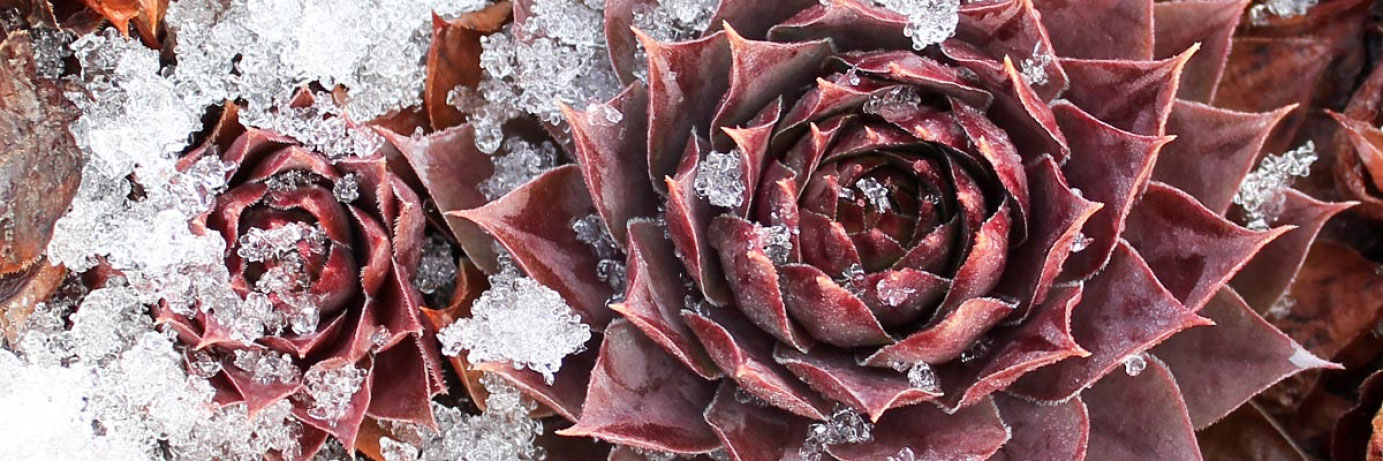
Garden Soil and Potting Mix
One of the most crucial parts of working with succulents is having a well-draining soil. Succulent roots will rot if they sit in water or wet soil for too long. If the soil you are working with doesn’t drain well, you can add a soil amendment such as pumice, perlite, or coarse sand. These will help loosen the soil and allow the water to drain more quickly, thus allowing the soil to dry faster. When planting succulents in the ground, creating mounds or planting on a hill will also help increase the drainage.
It is even more important to have well-draining soil for succulents grown in containers. In general, it’s best to use a pot with a drainage hole to allow water to flow out of the pot. Succulents will do best in a soil with a particle size of roughly ¼” or 6mm. Standard potting soil is too dense for succulents and doesn’t allow their roots to get the oxygen they need.
While most store bought succulent and cacti mixes (e.g. Miracle-Gro Cactus, Palm, and Citrus, Black Gold Cactus Mix) will be fine for succulents, mixing your own will generally produce the best results. The best ratio for succulent soil is ⅓ organic material such as coconut coir or pine bark fines and ⅔ inorganic material such as crushed granite, coarse grain sand, perlite or pumice.
Read more about this topic at Succulents and Sunshine: Well-Draining Succulent Soil
Using a top dressing, such as a pea gravel or decorative rock is recommended. It adds a professional touch to an arrangement and minimizes moss growth. A top dressing also keeps succulent leaves off of the soil which can help prevent rot.
Read more about this topic at Succulents and Sunshine: Top Dressings
Your succulents will also benefit from regular fertilizer. Use a fertilizer with low nitrogen such as a 5-10-10. It’s best to dilute the fertilizer to half strength to prevent burning your succulents. Spring is generally the best time to fertilize as this is when most succulents begin actively growing.
Read more about this topic at Succulents and Sunshine: Fertilizing Succulents

Watering
A common misconception is that succulents don’t need very much water to survive. They in fact need enough water to keep their leaves, stem and root full in order to withstand periods of drought.
The best way to water succulents and encourage healthy root growth is to completely soak the soil and allow it to dry out completely before watering again. Lightly spraying the soil will cause succulents to put off small thin roots which will easily wither and die. Soaking the soil allows them to absorb the water they need. Letting the soil dry out completely allows the succulent time to grow and put off strong healthy roots.
How frequently you water is greatly determined by your climate, soil and the type of succulents you are growing. When the weather gets hot your succulents will need more water than in the winter when it’s cold and they are dormant. Succulents with thick leaves will tolerate longer periods of drought, whereas succulents with thinner leaves will need to be watered a little more frequently.
Watering once a week is a good place to start if you’re unsure of how often to water. However, you’ll want to adjust based on temperature and the type of succulent you’re growing. Look for signs of watering problems to help determine if you need to increase or decrease your watering frequency. Making gradual changes to the watering frequency as you notice early signs of over or under watering will help ensure your succulents stay healthy.
Read more about this topic at Succulents and Sunshine: How to Water Succulents
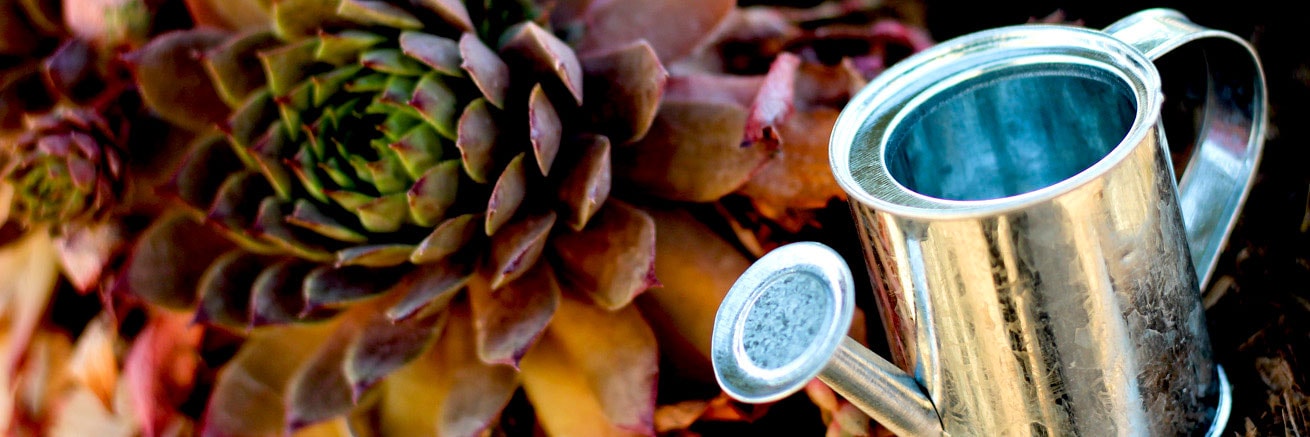
Symptoms of Water Problems
Over watering is one of the most common ways to kill succulents. An early sign of over watering is your succulent’s leaves falling off with just a slight bump. As the damage from over watering continues, your succulent’s leaves will begin to yellow and look more transparent. The leaves will feel mushy and wet. At this point the best option is to let your succulent dry out for a few days and reduce your watering frequency in the future.
If your succulent starts to blacken around the stem or leaves, it is suffering from rot. You’ll want to cut off the succulent above the rot, allow the cutting to dry for a few days and then replant the cutting in soil.
When a succulent isn’t getting enough water you’ll notice the leaves start to look limp and soft. You may begin to notice wrinkling near the top of the plant in the new growth. The lower leaves of succulents will die eventually as part of their normal life cycle. If you notice that the leaves are drying up faster than usual, you’ll want to increase your watering frequency slightly.
It’s much easier to rescue a succulent that has been under watered so when in doubt, water less often. Then, if you notice signs of under watering, gradually increase how often you’re watering.
Read more about this topic at Succulents and Sunshine: Rescuing Over and Under Watered Succulents
Photo: Left shows underwatering for a Portulacaria. Right shows overwatering for an Echeveria.

Containers
Succulents are tough plants and can grow in a variety of places. For long term growing, it’s generally best to place them in a container with a drainage hole and to use well-draining soil. While you can plant succulents in fun containers with no drainage such as old shoes, tea cups, votives, etc. they may not be the best long term solutions due to watering challenges. Terracotta or ceramic pots will dry out more quickly than plastic or other materials, so be sure to adjust watering accordingly. As succulents get too big for the container they are in, you can cut back the new growth and plant it elsewhere or move the whole plant to a larger container.
Read more about this topic at Succulents and Sunshine: Choosing Pottery for Succulents
Browse our selection of pots for succulents here: Pots for Succulents
Most succulents also perform well in raised beds and rock gardens where they can be easily viewed. You'll want to check the hardiness rating on any succulents before you plant in the ground to make sure they will survive the winter in your zone. Also be sure to plant them in well draining soil.

pests & diseases
Mealybugs are the most common pest for succulents, although they generally only affect succulents in containers. Aphids are another common pest, usually appearing in the summer. Mealybugs, aphids, and most other pests, can be treated by spraying the succulent with 70% Isopropyl alcohol or an insecticidal soap. Be sure to get in between the leaves and near the stem as bugs tend to hide in the crevices. It may take several applications to completely get rid of all the bugs.
Read more about this topic at Succulents and Sunshine: Treating Mealybug Infested Succulents

Air Plants - Tillandsias
Tillandsias are low maintenance plants that only require water. Most varieties do fine with weekly misting/showering, but larger plants need to be dunked in water for 15-20 minutes per week. These plants will thrive in dry or humid climates as long as they receive adequate moisture. Direct sunlight is not recommended, but often times will inspire color with in some varieties. It is important to drain the water out of the crevices. When using Tillandsia for terrariums or art projects they cannot be used with any potting soil or dirt (hence the name Air Plants). Air Plants can be used with sand, sea glass, rocks, pebbles & bark chip. Tillandsia will color up and also spike a bloom that will flower. They also produce pups that create a whole other plant.

Propagation
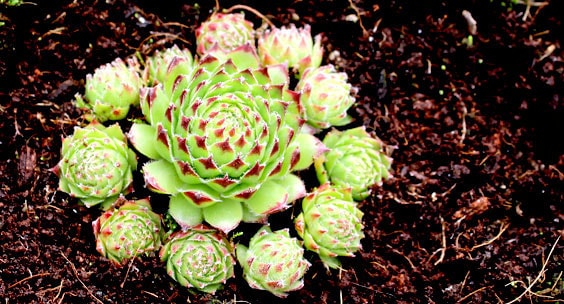
Chicks or Pups
Many succulents such as Sempervivum (Hens and Chicks) and Echeverias will put off new chicks each year. Chicks can be left on the mother plant to continue growing or removed and planted elsewhere. To remove, simply cut the stem that connects it to the mother plant. Let the chick dry for a few days in a cool, shady area then plant in well-draining soil. Care for the chick similarly to a fully established plant, watering only when the top soil is dry.
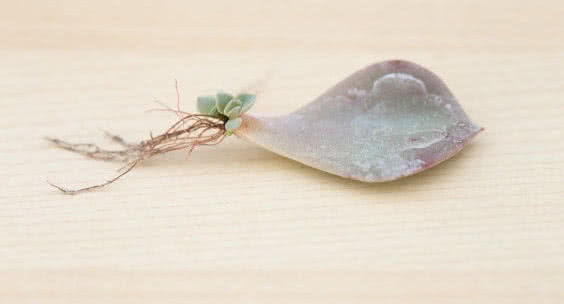
Leaf Propagation
Many Soft Succulents can be propagated from their leaves. To remove a leaf, gently twist and pull the leaf off the stem. Let it sit on a dry surface for a few days and then place on top of soil. Keep the soil damp for a few weeks as roots and new plants begin to form. As roots begin to form, cover them with soil so they don’t dry out. As the plants begin to grow larger you can move them to a new area and begin caring for them as you would a full plant. It’s best to propagate in a warm shady area.
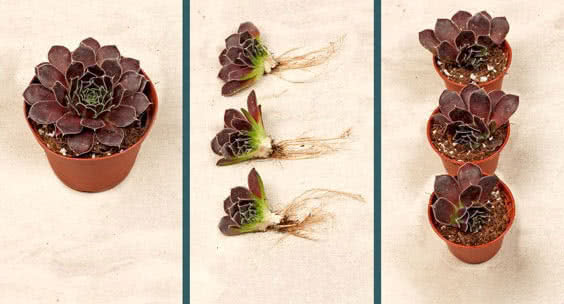
Sempervivum heuffelii
Heuffelii do not produce chicks like other Sempervivum and must be cut apart with a sharp knife, leaving a part of the carrot-looking root on each section. Let cuttings dry in the shade for several days before planting. Water requirements are the same as for other Sempervivum.
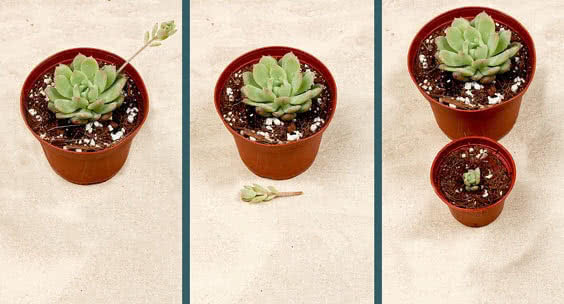
Sedums and Soft Succulents
Many of the Sedums and Soft Succulents can be propagated by removing and planting offsets, extra stems, cuttings, or just leaves.
Recommended Books
These e-books by Cassidy Tuttle of Succulents and Sunshine are excellent, affordable, and easy-to-read primers
for succulent care and propagation tips. Click for more info:

